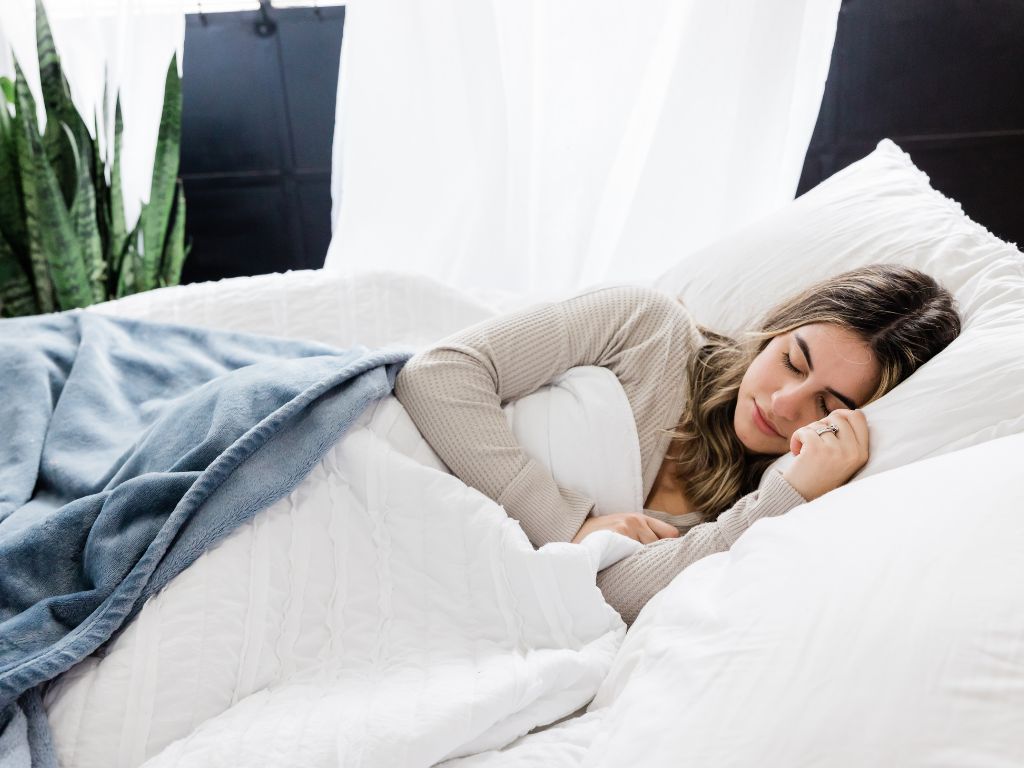Obstructive sleep apnea (OSA) is a sleep disorder characterized by repeated pauses in breathing during sleep. This happens when the throat muscles relax and block the airways. Such interruptions can occur numerous times throughout the night, disrupting normal sleep patterns and resulting in loud snoring, daytime fatigue, and other symptoms.
OSA is alarmingly prevalent, affecting an estimated 39 million adults in the United States alone. However, this condition is often underdiagnosed, and many individuals experience symptoms without understanding why.
Sleep apnea is considered incurable, but there are some therapy options and lifestyle changes available to those with OSA.
What Causes Sleep Apnea?
Sleep apnea occurs when the muscles in the throat relax excessively during sleep, leading to the collapse of soft tissues and obstruction of the airway. This can be caused by a variety of risk factors, including physical traits and lifestyle factors.
Common Risk Factors for Sleep Apnea
- Obesity: Excess fat deposits around the upper airway can obstruct breathing.
- Anatomical Factors: Structural abnormalities such as enlarged tonsils, a narrow airway, or a large tongue can contribute to airway obstruction.
- Age: As people age, muscle tone in the throat tends to decrease, increasing the risk of airway collapse.
- Gender: Men are two to three times more likely than women to develop sleep apnea, although the risk for women increases after menopause.
- Family History: There may be a genetic predisposition to sleep apnea.
- Alcohol and Sedative Use: These substances can relax the muscles in the throat, exacerbating airway obstruction during sleep.
- Smoking: Smoking can increase inflammation and fluid retention in the airway, contributing to obstruction.
- Medical Conditions: Conditions such as hypertension, congestive heart failure, diabetes, and hypothyroidism are associated with an increased risk of sleep apnea.
Neuromuscular Disorders: Conditions that affect muscle control, such as Parkinson’s disease or muscular dystrophy, can lead to airway collapse during sleep.
Symptoms of OSA
Individuals with obstructive sleep apnea can experience a range of side effects. Some of the most commonly reported symptoms include:
- Loud and chronic snoring
- Gasping or choking sensations during sleep
- Pauses in breathing during sleep witnessed by others
- Excessive daytime sleepiness
- Morning headaches
- Dry mouth or sore throat upon awakening
- Restless sleep
- Insomnia or difficulty staying asleep
- Attention problems
- Irritability or mood changes
- Decreased libido or sexual dysfunction
- Frequent nighttime urination (nocturia)
Untreated OSA can also lead to many serious health consequences, including hypertension, cardiovascular disease, stroke, diabetes, and cognitive impairment. If you’re experiencing any of the symptoms listed above, it’s important to work with a healthcare provider to manage your risks.
Match With Sleep Apnea Research Studies
Do the symptoms of sleep apnea sound familiar? Have you or your loved one been diagnosed with OSA?
You may qualify for a trial nearby. Tandem Clinical Research will match you with
- Research studies in your area.
- Cutting-edge OSA treatments.
- The latest clinical research.
How Is Sleep Apnea Diagnosed?
Clinical Evaluation
Healthcare providers often begin by conducting a thorough medical history and physical examination to assess symptoms and risk factors associated with OSA. They may inquire about the individual’s sleep habits, daytime symptoms, and overall health.
Sleep Studies
Sleep studies, or polysomnography, are the gold standard diagnostic tests for OSA. These involve spending a night in a sleep center. There, various physiological parameters (such as brain activity, eye movements, and breathing patterns) are monitored during sleep.
This comprehensive evaluation helps to identify the presence and severity of OSA.
Home Sleep Apnea Tests (HSAT)
Home sleep apnea tests may be an option for individuals with suspected moderate to severe OSA and no other significant medical conditions.
These portable devices monitor breathing patterns, oxygen levels, and other parameters while the individual sleeps in the comfort of their own home. Although HSATs are convenient and cost-effective, they may not capture all the aspects of sleep physiology compared to in-lab polysomnography.
Other Assessments
In some cases, additional assessments may be needed to evaluate specific aspects of OSA or its potential complications. These may include measurements of daytime sleepiness using questionnaires like the Epworth Sleepiness Scale, imaging studies to assess airway anatomy, or tests to evaluate cardiovascular health.
Regardless of the method, accurate diagnosis is crucial for implementing appropriate OSA treatment strategies and minimizing the potential health risks.
Preventing Sleep Apnea & Its Symptoms
Treating OSA
As previously mentioned, there is no cure for sleep apnea. However, patients with OSA can use certain methods to minimize their symptoms and reduce their risk of further health complications.
Common treatment options include…
Breathing Devices
Continuous Positive Airway Pressure (CPAP) therapy is the most common and effective treatment for moderate to severe obstructive sleep apnea.
CPAP devices deliver a steady stream of air through a mask worn over the nose or both nose and mouth during sleep. This air pressure helps to keep the airway open, preventing breathing pauses and snoring.
Some individuals may use bi-level positive airway pressure (BiPAP) machines instead. These deliver varying levels of pressure during inhalation and exhalation.
Oral Appliances
Also known as mandibular advancement devices (MADs) or mandibular repositioning devices (MRDs), these oral appliances are custom-made to be worn during sleep. They work by repositioning the lower jaw slightly forward, which helps to keep the airway open and prevent obstruction.
Oral appliances are often recommended for individuals with mild to moderate OSA or those who cannot tolerate CPAP therapy. They are comfortable, easy to use, and portable, making them a convenient alternative for some patients.
Oral Facial Therapy
This style of therapy involves a combination of lifestyle modifications, exercises, and techniques aimed at improving airway function and reducing the severity of obstructive sleep apnea. This may include…
- Weight loss
- Positional therapy (encouraging sleeping on the side rather than the back)
- Orofacial myofunctional therapy ( to strengthen muscles of the mouth and throat)
- Other interventions to address underlying factors contributing to OSA.
While oral facial therapy may not be as effective as CPAP therapy for severe OSA, it can be a valuable adjunctive treatment or a primary option for individuals with mild OSA or positional sleep apnea.
Surgery
Individuals with severe OSA may require surgical intervention, especially if they have not responded to conservative treatments or are unable to tolerate CPAP therapy.
Surgical options aim to enlarge the airway by removing or repositioning tissues that contribute to obstruction. Common procedures for OSA include…
- Uvulopalatopharyngoplasty (UPPP)
- Tonsillectomy
- Adenoidectomy
- Maxillomandibular advancement (MMA)
- Hypoglossal nerve stimulation
While surgery can be effective in reducing the severity of OSA and improving symptoms, it is generally reserved for extreme cases in which other treatment options have been unsuccessful or are not feasible.
Match With Sleep Apnea Research Studies
Tandem Clinical Research connects patients with clinical trials for biotech, pharmaceutical, and medical device companies. If you live near or in New Orleans, we’ll help you learn if you qualify for a local OSA trial.
If you or your loved one has sleep apnea, consider joining a clinical trial. Your participation can contribute to the next wave of OSA discoveries, benefiting both you and future patients.
How to Care for Loved Ones With OSA
It can be difficult to know how to care for a loved one with obstructive sleep apnea. Although there is not all that much you can do to alleviate their symptoms, here are some tips for supporting them on their journey:

Encourage Treatment Adherence
Help your loved one adhere to their prescribed treatment plan, whether that’s using a CPAP machine, wearing oral appliances, or making lifestyle changes. Offer encouragement and support as they adjust to their treatment regimen, and when possible, offer to join them in their efforts.

Create a Sleep-Friendly Environment
Another thing you can do is help create a comfortable environment that’s conducive to high-quality sleep for your loved one. This may involve minimizing noise and light disturbances, ensuring the bedroom is cool and dark, and providing supportive pillows or positional aids to encourage side sleeping.

Educate Yourself and Offer Support
Take the time to learn about obstructive sleep apnea, its symptoms, and treatment options. Offer emotional support and reassurance, and do your best to be a source of encouragement. Sometimes, even just offering a listening ear can make all the difference.

Seek Professional Help When Needed
Lastly, if you notice that your loved one is struggling with their OSA symptoms or treatment, encourage them to seek professional help. This may involve consulting with their healthcare provider or a sleep specialist to address any concerns or difficulties they may have.




